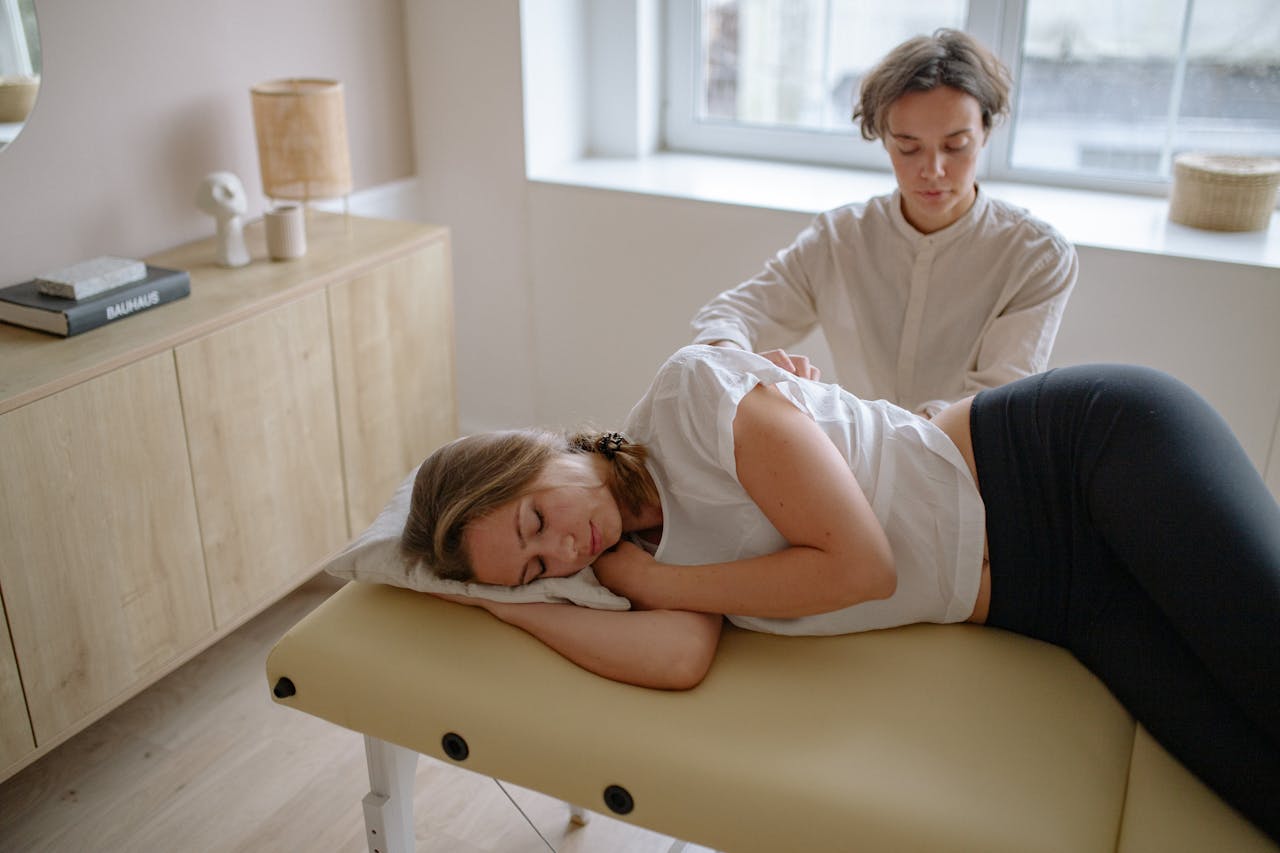6
What is Lordosis?
Last Updated: November 5, 2024

Table of Contents
Lordosis is an abnormal curve of the spine, typically in the lumbar region but not exclusively. Some curvature in the spine is normal, but too much or too little can negatively affect the body and can result in back pain, limited range of motion and muscle fatigue
Key Takeaways
- Definition: Lordosis refers to an excessive inward curve of the spine, typically in the lower back.
- Causes: Can be caused by poor posture, obesity, spinal conditions, or muscular imbalances.
- Symptoms: Common symptoms include lower back pain and discomfort, particularly when standing or walking.
- Diagnosis: Diagnosed through physical exams and imaging tests like X-rays.
- Treatment: Involves physical therapy, exercises to strengthen the core, and, in severe cases, surgery.
- Prevention: Maintaining good posture and a healthy weight can help prevent lordosis.
Lordosis Explained
Lordosis refers to an inward curve of the spine. Some inward curvature is normal in the cervical (neck) and lumbar (lower) spine, but an excessive curve can lead to pain, discomfort, difficulty walking, and other spinal conditions.
Many factors may cause lordosis, including:
- poor posture
- pregnancy
- obesity
- genetic abnormalities
- or injury
Treatments for lordosis vary depending on the severity of the condition but may include exercise, physical therapy, postural correction and in severe cases, surgery.
Types of Lordosis
Differences in shape and degree of the lordotic curve are classified differently depending on the curve's severity, direction, shape, and location.
Different degrees of lordosis affect people in unique ways, sometimes causing pain or muscle abnormalities. In most cases, lordosis is managed well and does not require treatment.
Benign Juvenile Lordosis
As they grow, some children will develop lordosis. This type is called benign juvenile lordosis. Changes in the spine are a normal part of a child’s age-appropriate development. Typically, this causes no issues and corrects itself as a child grows.
Benign juvenile lordosis occurs when muscles surrounding the hip joints are too weak or tight, causing an imbalance and pulling the pelvis out of alignment. This postural lordosis often corrects itself without professional medical intervention.
Still, a professional opinion from a child’s doctor is the best way to confirm if the condition needs treatment.
Lumbar Hyperlordosis
Hyperlordosis is when the lower (lumbar) spine curves too inward. This exaggerated inward curve puts abnormal stress on the pelvis and causes a shift in how someone walks, also called their gait pattern.
Lumbar hyperlordosis may also lead to muscle pain and poor posture. Hyperlordosis is the most commonly diagnosed form of lumbar lordosis.
Lumbar Hypolordosis
If the lumbar spine begins to curve outward or if the inward curve reverses and causes the spine to lie flat, this is called hypolordosis.
As another form of lumbar lordosis, hypolordosis affects the lower spine, called the lumbar region.
Cervical Lordosis
The cervical spine is composed of the first seven vertebrae below the head. Like the lumbar spine, the cervical spine should have a slight curve inward.
If there is an exaggerated inward curve in this area, this is called cervical lordosis. An extreme curve in the upper back and neck (cervical lordosis) is often associated with headaches and neck pain and can be a component of upper cross syndrome.
Thoracic Lordosis
Unlike the cervical and lumbar portions of the spine, the natural curve of the thoracic (middle) spine goes outward toward the back of the body. This outward curve is called kyphosis.
Because the thoracic spine should curve outward, having a lordotic inward curve in the thoracic spine is abnormal. Thoracic lordosis is rare compared to cervical and lumbar lordosis and is more likely to cause painful symptoms.
Neuromuscular Lordosis
Neuromuscular lordosis, or NML, is accompanied by more serious spinal conditions, like spina bifida or extreme muscular dystrophy. NML requires invasive surgery to correct and unlikely to be remedied with postural adaptation or bracing.
In most cases, neuromuscular lordosis develops because of an underlying genetic condition that causes the pelvis to shift from its proper vertical alignment, making it lie flat.
Due to the serious symptoms associated with this type of lordosis, people who suspect their lordosis is neuromuscular should seek medical help immediately.
Symptoms of Lordosis
Because some degree of curve in the spinal is normal, symptoms will only present in cases of severe lordosis. These symptoms may include:
- Back pain
- Muscle pain, especially in the lower back and neck
- Swayback appearance
- Limited range of motion of the back
- Difficulty or pain standing or sitting
- An exaggerated curve in the spine when standing
- Abnormal fatigue in the back muscles
Symptoms of lordosis can affect a person’s quality of life and ability to work. Diagnosing these symptoms to find the cause of lordosis is the first step to finding an effective treatment.
Diagnosis
There are no clear parameters for the diagnosis of lordosis. There is no set range of acceptable curvature for the spine - it varies from person to person and depends on one’s medical history.
A spine specialist has the best training to determine if someone’s level of lordotic curve constitutes a medical concern.
Diagnosis by Imaging
In severe cases where a physical examination is insufficient, doctors often use a diagnostic imaging procedure to diagnose lordosis. Magnetic resonance imaging (MRI), x-rays, and CT scans produce detailed images of the spinal curve, giving doctors the information they need to provide a diagnosis.
Doctors may also use computer technology to measure and assess standing posture and gait. In cases where damage to the spinal cord may occur, having lordosis diagnosed by a professional healthcare provider is imperative to reducing the chances of injury.
As lordosis can be a symptom of a more serious condition, seeing a doctor can be instrumental in the early detection of other conditions.
Having lordosis listed on a complete medical history can provide insight for doctors in the future in cases where more serious issues with the spine can develop.
Occasionally, bone density is measured to detect bone diseases where lordosis is an observable symptom. Health conditions that reduce bone density or cause bone pain may have lordosis as a symptom.
Causes of Lordosis
Several different factors can cause an exaggeration in the natural curvature of the spine. Postural factors, such as poor posture in pregnancy or extended time spent in poor seated posture over weeks or months, can contribute.
Technical factors, including previous spinal surgery, neuromuscular disorders, or bone diseases, can also cause lordosis.
Many of the same conditions that cause poor spine postures, like muscular dystrophy, weak abdominal muscles, overly tight abdominal muscles, and hip flexion contracture (an inability to straighten the hips), can also contribute to lordosis.
Postural Factors
The body adapts to the positions and actions where it is most frequently used. The spinal curve is flexible, but holding it in an abnormal or unhealthy position for an extended period can cause the body's internal tissues to become rigid, solidifying poor posture with that excessive curve.
An extreme bend forward, slouching, sitting with no lumbar support, or carrying excessive weight from obesity or pregnancy can lead one to develop lordosis.
Technical and Disease Factors
Poor posture is the most common cause of lordosis, but it is not the only cause. Lordosis may develop in some cases of work or sports injuries, in some spinal conditions, or following spine surgery.
Depending on the severity and root cause, postural corrections and manual therapy may still adequately remedy the condition.
Treatment of Lordosis
Following a physical exam or another diagnostic test, a doctor will often prescribe one or more forms of treatment for lordosis.
These treatments aim to reduce pain, improve posture, prevent the worsening of symptoms, and develop or maintain a healthy spinal curve.
Bracing
One standard clinical treatment for lordosis is bracing. Bracing involves a special orthotic device, a lordotic brace, that wraps around the lower back and encourages the spine back into its proper curve.
Bracing is effective at restoring a healthy spinal curve, but braces are often uncomfortable and inconvenient to wear for long periods, and a customized brace is expensive. Lordosis treated by bracing has the potential to return once a person has removed the brace, making it only part of a long-term solution.
Manual Therapies
Manual therapies, like massage and physical therapy, are some of the most commonly prescribed treatments for lordosis.
These therapies treat the underlying causes of postural lordosis rather than treating the symptoms. If tight muscles are causing a misalignment of the spine, massage can effectively relieve that tension.
In cases where injuries or a lack of movement have caused the shortening of muscles or alterations of healthy movement patterns, physical therapy is helpful to restore the spine’s natural curves.
Postural Correction
The most effective solution to lordosis is through postural correction. Even after bracing or manual therapy, the postural patterns that lead to lordosis must be fixed to ensure the spine doesn’t return to its previous excessive curvature.
Strength Training
Because lordosis is often caused by imbalances or muscle weakness, strength training is an effective and necessary means to keep the spine in alignment.
Maintaining good posture becomes much easier when weak abdominal muscles or posterior back muscles are strengthened.
Surgery
Some extreme cases of lordosis may require surgery. Surgery is normally the last option and should only be considered when other treatment options have been exhausted without success. Always speak to a doctor before deciding on surgery.
Frequently Asked Questions
How can I tell if I have Lordosis?
In a sense, everyone has lordosis. The inward curve itself is called lordosis, and those curves are supposed to be there.
It is only in conditions of too much (hyperlordosis) or too little (hypolordosis) curve that lordosis becomes a problem.
How much curve is too much?
Excessive lordosis can become problematic if the curve abnormally impacts the spinal cord or causes severe symptoms. There is no standardized level of spine curve; individual differences vary widely.
For this reason, it is always important to speak to a doctor. Especially in cases where children are experiencing significant spinal curvature, parents should consult a child’s doctor to assess if that curve is normal.
Who does Lordosis affect?
Excessive lordotic curvature typically affects people with poor posture, bone wasting or degenerative diseases, sports injuries, or other conditions. Maintaining proper posture is the best strategy to avoid developing lordosis.
References
The relationship between tight hamstrings and lumbar hypolordosis in children with cerebral palsy
Swayback vs Lordosis: Hyperlordosis Of The Lumbar Spine
Lumbar Lordosis: Effects of Sitting and Standing
Lordosis | Boston Children's Hospital
Effects of Lumbar Stabilization Exercises
Disclaimer
The contents of this article are provided for informational purposes only and are not intended to substitute for professional medical advice, diagnosis, or treatment. It is always recommended to consult with a qualified healthcare provider before making any health-related changes or if you have any questions or concerns about your health. Anahana is not liable for any errors, omissions, or consequences that may occur from using the information provided.

Dr. Darlene Buan-Basit is a highly experienced licensed Chiropractor and Pilates instructor with expertise in many techniques, including Medical Acupuncture, Traditional Chinese Medicine, and Advanced Massage Techniques.
